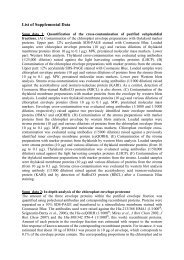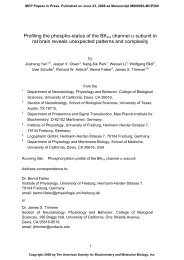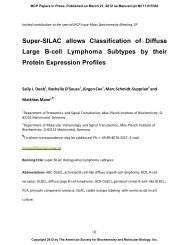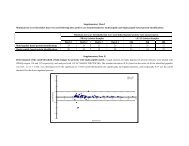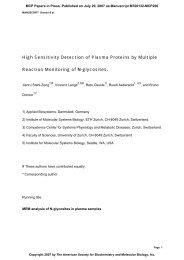MSDaPl - Molecular & Cellular Proteomics
MSDaPl - Molecular & Cellular Proteomics
MSDaPl - Molecular & Cellular Proteomics
Create successful ePaper yourself
Turn your PDF publications into a flip-book with our unique Google optimized e-Paper software.
DATA ARCHITECTURE<br />
<strong>MSDaPl</strong> is supported by four primary databases (referred to here as “msData,”<br />
“NR_SEQ,” “Job Queue”, and “Projects Database”) and several ancillary databases created to<br />
provide biological context to MS/MS results (Figure 2). The SQL required to generate these<br />
databases for the MySQL RDBMS is available with the <strong>MSDaPl</strong> distribution at<br />
http://code.google.com/p/msdapl/.<br />
MSDATA DATABASE<br />
At the heart of <strong>MSDaPl</strong> is a database schema, dubbed “msData”, designed to be<br />
independent of any specific mass spectrometry pipeline. This is accomplished by conceptually<br />
separating typical mass spectrometry analysis into three fundamental areas: (1) the raw mass<br />
spectra, (2) peptide searches (including post-translational modifications), and (3) protein<br />
inference. Data describing each of these three areas (regardless of the particular analysis<br />
pipeline) will likely have common attributes, as they are describing the same kind of analysis.<br />
These common attributes are abstracted into a core set of tables in each of these three areas, and<br />
these core tables are populated for every MS run, peptide search, or protein inference result set<br />
loaded into the database. Since all data are represented homogeneously in these core tables, these<br />
core attributes may be searched and displayed using a common interface and results compared<br />
and contrasted across experiments and disparate pipelines.<br />
The core tables may be extended in order to encapsulate data specific to particular mass<br />
spectrometry analysis programs (Figure 3). This is done by creating a new table in the schema<br />
specific to an analysis program where each row may be considered a horizontal extension of the<br />
rows from the core table. For example, a row representing a result in the peptide search results<br />
core table may have a corresponding row in the Mascot(18) results table that acts as a logical<br />
extension of this table. This row in the Mascot table would contain data specific to Mascot that<br />
8



